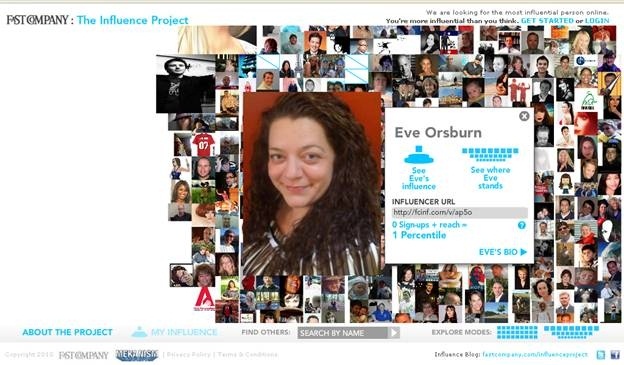Did You Know Fast Company Magazine Wants To Feature You?
By Sawyer ReedThere may come a time in your life when you need a large number of people to do one simple thing for you. Will they? How might you go about asking the favor of these people? And how would you know they’d do it? …IDEA! You use your social networks to spread the word. A good example is a project like this one: http://fcinf.com/v/ap5o

As a college student, I see things like this all the time. For example: students ask all their friends on their respective social network, via mass messages, to “complete this short survey for my Sociology 314 midterm!”. I also see these types of messages from people whom I’ve never met, nor even heard of via friends I have met and heard of, and with whom I just so happened to be connected.
The minds at Fast Company have created a project that deals directly with this type of situation. The Influence Project was designed to find the “most influential person on the internet”. According to Fast Company, influence isn’t a matter of how many friends or followers one has, but more a matter of being able to affect the behavior of these people. The Influence Project works in such a way as to find the participant who has the biggest effect on other people on the internet. By assigning a unique URL (that directs to the project website) to each member of the project, Fast Company is able to track what kind of influence a user has.
The website to which the URL links is quite interesting. A seemingly endless array of user photos that can easily be scrolled through simply by moving the mouse, shows photos, large and small, of every member of the Influence Project. The size of each individual user’s photo depends on the amount of “influence” that Fast Company has tracked for that user. Every time the user’s unique URL is clicked, the user’s image grows.
If an individual user’s photo is selected on the Project’s site there are options to view that user’s influence, and where he or she stands in the list of most influential people. The user’s influence is separated by degrees. Say a unique link is clicked by a person who, in turn, registers with the project and influences others to click their link; the original influencer gets a fraction of an influence “credit” and a little bigger photo on the site.
At the end of the project, every picture will appear (in their respective sizes) in a photo spread in Fast Company Magazine, and the most influential person on the internet will be revealed. At that point, I will become friends with this “most influential person” and hope that they may be able to help me with a sociology midterm in the future.
To check out the project and possibly sign up for yourself, click here: http://fcinf.com/v/ap5o
